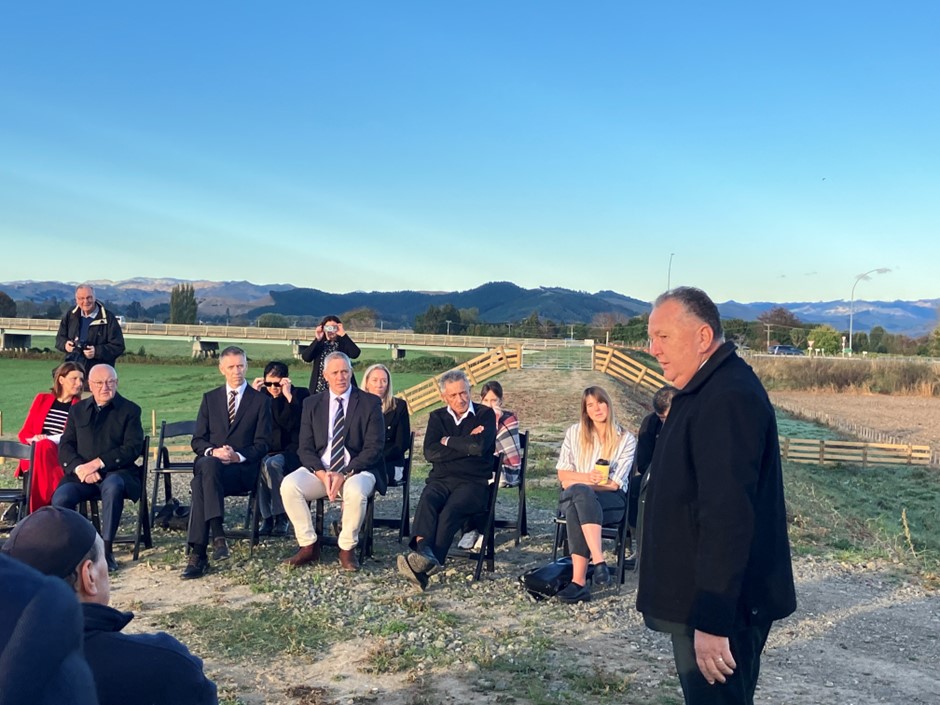Friday 19 April, 2024
Minister of Regional Development the Hon Shane Jones was in Tairāwhiti today alongside iwi, contractors and the Mayor to officially mark a significant milestone for our region.
Twenty-five kilometres of stopbanks from Ormond to the ocean have been widened and made taller to account for climate change effects out to 2090.
Mayor Rehette Stoltz told the gathered crowd during this morning’s ceremony that this stretch of stopbanks during Cyclone Gabrielle protected our city and 10,000 hectares of fertile floodplain land, which grows food for our region and the whole country.
“Thank you Minister Jones for being here to mark this significant achievement today.
“The Government funding of $7.5 million has been a major boost and means we can complete the Waipaoa River Flood Resilience Project which after Cyclone Gabrielle showed how important this project is.”
Standing on top of the stopbanks this morning, Minister Jones said he saluted the mahi that had gone into this project.
“Please have confidence we’re going to continue in this direction, this is the most enduring contribution I can make as a politician. We’re going to protect ourselves from excesses in the weather.”
The Eastern side of the Waipaoa River Flood Resilience Project in Gisborne has been partly funded by Kānoa with $7.5million of external funds received.
The resilience project is building on top of the great work of The Waipaoa Flood Control Scheme, which is 64km of stopbanks along the Waipaoa River, together with other river control structures and protection works.
It was built between 1953 and 1967 to provide flood protection to the Poverty Bay floodplains and Gisborne city and is one of Council’s most valuable assets.
Mayor Stoltz said this resilience work adds on to the earlier work in our region.
“We are now building to account for higher intensity rain events and rising sea levels.”
The milestone means the Eastern (city) side is now complete.
The focus of the project now moves to the Western side, where 18kms have already been completed downstream of the Patutahi township.
Mayor Stoltz said work will continue upstream of Patutahi, with 22kms of stopbanks to be progressively upgraded to a higher level of flood protection.
“Through careful construction, these stopbanks have increased in height by about 1-2 metres in some places and been widened out to four metres on top, from the original 1.5 metre crest.”
Mayor Stoltz says the already heightened stopbanks saved the city during Cyclone Gabrielle.
“It’s estimated about half metre to one-metre deep water would have flowed towards the city if the increased stopbanks hadn’t been there.”
Construction work got underway on the resilience project in 2019. It’s expected to be finished in 2027, subject to favorable weather conditions, which will be 2-3 years ahead of schedule.
The Waipaoa River winds its way south from its headwaters north of Whatatutu Township to the Waipaoa River mouth at the end of Centennial Marine Drive out into Tūranganui a Kiwa / Poverty Bay.
Along its 80-kilometre journey out to sea, it passes through the townships of Te Karaka, Ormond and Patutahi. There are also significant tributaries that feed into it on the way.

A ceremony was held at sunrise on top of a completed portion of the Western side stopbanks along the Waipaoa River this morning. From left are Morehu Pewhairangi from Te Aitanga a Mahaki iwi, Mayor Rehette Stoltz, Minister Shane Jones, Rongowhakaata Iwi Trust Chair Staci Hare and Earthwork Solutions Managing Director Matt Mead.
Picture above by Paul Rickard Gisborne Herald.

Minister Shane Jones speaks at this morning’s ceremony to mark the completion of the Eastern side of the stopbanks, and most of the Western side, as part of the Waipaoa River Flood Resilience Project to protect our region from the future impacts of climate change.
